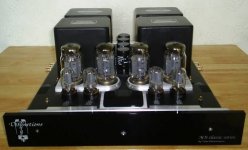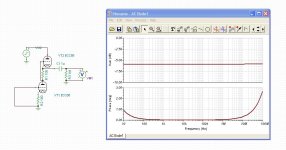Popilin:
You remember you said my input impedance was 39K in my poweramp? I thought to myself how did you come up with that nr?
Now it hit me, you looked at the schematic at the resistor! but it is wrong! It's says 39K but it's 510K!!! What does this change? Regarding coupling caps? Can i safetly change this down to 100K in worst case?
No problem with 100K, neither with 510K.
Gold rule of dumb: If it works, don't touch it !
I tell you this as a TV repairman, every time I don't follow this rule, I lose money. 😀
I tell you this as a TV repairman, every time I don't follow this rule, I lose money. 😀
hehehe 😀 I recognize that =)
I am always terrified of opening an amp up once it is finished as I always generally end up breaking something in the job.
Of course I generally have very tight and messy builds.
Shoog
Of course I generally have very tight and messy builds.
Shoog
Hi,
Max,is your signal going through the volume pot (50K)?
If so then your input impedance is 50k//510K = 45k5
Ciao, 😉
Max,is your signal going through the volume pot (50K)?
If so then your input impedance is 50k//510K = 45k5
Ciao, 😉
Here is the schematics of my poweramp, Yaqin MC100b.
According to technical data online i saw it has a input imp of 20k. BUT the volumepot is removed - I use it as a poweramp only. I don't know what that do to the input imp... 😕 So it only uses the "0.6V" input now.
EDIT: Also the switch is gone. The signal goes straight into each 12ax7!
Hi,
Max,is your signal going through the volume pot (50K)?
If so then your input impedance is 50k//510K = 45k5
Ciao, 😉
Difficult to say now, amp/preamp circuits change dynamically and very fast... 😀
LOL.
Could also skip the 12AX7 stage come to think of it....
Ciao, 😉
 😀
😀Hi,
Max,is your signal going through the volume pot (50K)?
If so then your input impedance is 50k//510K = 45k5
Ciao, 😉
In poweramp: no
Preamp: yes
Stop it now both of you, you're killing me! I thought i updated here everytime i changed something?! 😉 this is nothing compared to when I was younger, changed sp n electronics every week hahaha!!!
And to answer, nothing have changed in my poweramp for many months now except some minor rewiring to get rid of two nasty switches. And my pre is still intact. And sounds almost too good. Very very revealing..
Only was that i got a bit afraid that my new couplingcaps were wrong value if now imp is different.
Is it 45k now or?
And to answer, nothing have changed in my poweramp for many months now except some minor rewiring to get rid of two nasty switches. And my pre is still intact. And sounds almost too good. Very very revealing..
Only was that i got a bit afraid that my new couplingcaps were wrong value if now imp is different.
Is it 45k now or?
Don't say never. I see one guy already skipped the first stage with the two 12ax7!! 🙂
Attachments
So fallow up to that, you guys just gave my an idea! First stage is apperently SRPP, why have two SRPP stages-seems stupid.
Just leave that n connect inputsignal to grid on 6sn7?
Haha this became so fun. No schuushing here !!!!! 😉
Haha ok i'll have to stop.
Just leave that n connect inputsignal to grid on 6sn7?
Haha this became so fun. No schuushing here !!!!! 😉
Haha ok i'll have to stop.
Stop it now both of you, you're killing me! I thought i updated here everytime i changed something?! 😉 this is nothing compared to when I was younger, changed sp n electronics every week hahaha!!!

And to answer, nothing have changed in my poweramp for many months now except some minor rewiring to get rid of two nasty switches. And my pre is still intact. And sounds almost too good. Very very revealing..
Only was that i got a bit afraid that my new couplingcaps were wrong value if now imp is different.
Is it 45k now or?
Without volume pot, 510K...at least it was a few hours ago 😀😀
Hi,
No, it won't work. I hadn't noticed that the SRPP stage's output is direct coupled to the 6SN7 phase splitter.
So, you're actually driving an integrated amp with a preamp and a CDP as a source.....😕
Ciao, 😉
Just leave that n connect inputsignal to grid on 6sn7?
No, it won't work. I hadn't noticed that the SRPP stage's output is direct coupled to the 6SN7 phase splitter.
So, you're actually driving an integrated amp with a preamp and a CDP as a source.....😕
Ciao, 😉
Hi,
No, it won't work. I hadn't noticed that the SRPP stage's output is direct coupled to the 6SN7 phase splitter.
So, you're actually driving an integrated amp with a preamp and a CDP as a source.....😕
Ciao, 😉
Not a CDP, but a standalone DAC with AKM4399/Xmos connected to PC with USB. Yes it have been integrated amp once with option (frontmounted RCA's) if you wanna use it as a poweramp only. (0.6V front vs 0.2V inputs at the back)
So if you're confused I'm even more. So what is a good solution you mean? the SRPP stage in my poweramp should be avoided?
I'll guess there is no "easy" way to transform this integrated amp into a "real" poweramp.
Last edited:
Got my GE 5670W tubes today (datecode 1975) 🙂
Also about to connect the internal shield (pin5) to ground. No harm doing that right? Tried to search the web but not much info about it.
Also about to connect the internal shield (pin5) to ground. No harm doing that right? Tried to search the web but not much info about it.
It seems to work quite well... but these GE 5670 "JAN" get hotter, like i can't touch them like i could with the russians.
First impression are that sound is warmer, little more laidback without any "edge" especially higher up. I'll guess some burning in are required. Anyway, quite like it now..more glow too =)
First impression are that sound is warmer, little more laidback without any "edge" especially higher up. I'll guess some burning in are required. Anyway, quite like it now..more glow too =)
Hi,
One word of warning for the more technically inclined:
SRPP: SHUNT REGULATED PUSH-PULL is a monstruous mis-nomer.
To be kind, at best it's a circuit that can be of use for driving a lowish impedance source of say 10K or less (preferably less) fixed input impedance whilst sill pertaining some gain (mu/2) but not much else.
The worst part however is its extremely poor PSRR.
IOW, lest you understand the circuit and have a particular use for, avoid it. It's a bit akin to a hoax really....
Ciao, 😉
All class A single ended circuits (tube or solid state) have poor PSRR compared to something like a differential opamp with bipolar power supplies.
The SRPP is better than most single ended class A circuits, with at least a negative PSRR. For example, see the attached simulation with a 6DJ8 SRPP with 180VDC supply and a 1 volt 120Hz sine wave applied to the upper tube's anode. Rejection is -6 dB or so, which is a lot better than say an EF86 gain stage which has a POSITIVE (as in it amplifies the noise on the B+) response.
Obviously, there are ways to take care of these problems, but it does take some effort.
Attachments
Can you please explain more detailed? What Can i do to improve it to be an ok SRPP? Components i have alot of. I saw in datasheet that they use 240R instead of here 470R (for biasing?) Somebody wrote that a srpp goes in class A just beacause it's an SRPP. Also other tube pre amps i've seen the rather use 1M to bleed of maybe gain (?) after and before cap? thats what its for right?
I've been doing some modelling with Duncans psu designer and and pretty hard to say what's the best (maybe i'm to slow🙂)
Well, the good news about single ended class A circuits is that they tend to draw fairly steady current from the power supply, so simple and local RC filtering often helps a lot.
The gain of this pre SRPP is about 22...23 dB, so it amplifies the input signal about 14 times.
This is more of a problem than an advantage. Usually quite little (6...10 dB) or no gain is required if typical signal sources - like CD players - are used.
I would use instead a voltage amplifying stage with some local negative feedback to adjust the gain at proper level and then a cathode follower as an output stage.
The volume potentiometer should be at the input or between the stages.
What I use is a switch between the gain stage and the follower stage so that the user can select high gain or low gain. If someone wants to listen to records (LP's), the output from the phono pre is usually low, as well as old FM tuners and other gear, so gain is needed. Obviously, no gain is needed for a CD or DVD player.
- Status
- Not open for further replies.
- Home
- Amplifiers
- Tubes / Valves
- My first preamp with tubes

